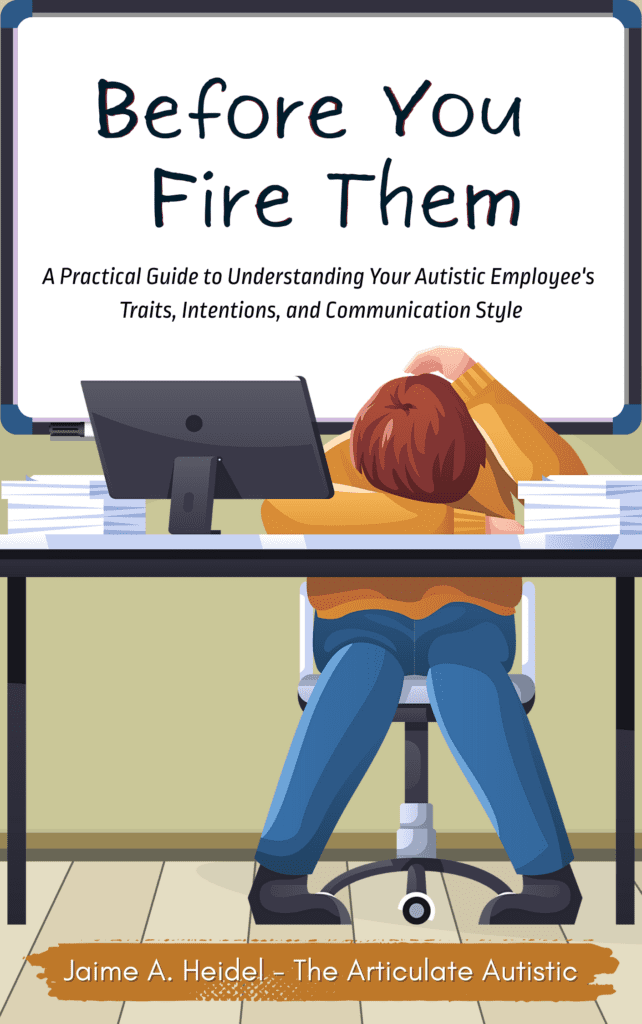“Why Does My Autistic Employee Always Seem Confused?”

Does your autistic employee frequently seem confused? Confusion in the workplace isn’t just frustrating; it can lower productivity, employee morale, and result in costly mistakes. As their supervisor, you feel you’ve been clear with your expectations, but something keeps getting lost in translation.
What’s going on?
First, let’s look at what’s not going on.
Autistic People Don’t Feign Confusion to Avoid Responsibility
One of the primary reasons managers become frustrated with their autistic employees is that, after a few failed attempts to clarify an instruction, they default to the belief that their employee must be pretending to be confused to get out of doing a task.
While I can’t speak for all autistic people, for the most part, this is not the case. The majority of autistic people do not pretend to be confused; we are confused.
The majority of autistic people do not pretend to be confused; we are confused.
Jaime A. Heidel – The Articulate Autistic
Your Autistic Employee Thinks and Learns Differently
The reason your autistic employee is confused isn’t because they’re pretending or even that you’re doing a poor job explaining; it’s that you both speak two different neurological languages, and it’s causing misunderstandings.
Let’s take a closer look at the differences in how neurotypical and autistic people think and learn, and how these differences can cause confusion:
Neurotypical
Neurotypical individuals rely heavily on nonverbal communication, such as body language, facial expressions, gestures, and tone of voice, to convey their feelings, needs, and expectations.
They also receive context cues from their environment, which offers even more nuanced information, allowing them to instantly match their verbal and non-verbal communication to the ever-shifting moods of the moment.
All of this occurs automatically (in seconds) within the neurotypical brain. They don’t need to think about it or try; it just happens.
Autistic
Autistic people rely heavily on direct and literal communication, either spoken, written, or indicated with an AAC (augmentative and alternative communication) device. We say what we mean, and we mean what we say.
Also, because many of us are bottom-up thinkers and processors, we may receive context cues from our environment. Still, those cues come in detail by detail instead of as a complete picture, so it can take longer to process (and respond to) that information.
The Disconnect
When a neurotypical person expresses themselves in their “native language”, the autistic person either cannot detect it, or the message comes across as vague and inconsistent, even contradictory.
When an autistic person expresses themselves in their “native language”, the neurotypical person may receive it as rude and demanding, even combative.
Neither understands what the other intends, and miscommunications abound.
Common Causes of Confusion in Autistic People
- Unclear or contradictory instructions
As a neurotypical person, even when you think you’re being clear, you may not be being clear in a way that translates to your autistic employees.
That’s not your fault; it’s just how your brain is wired!
“It would be great if this could get done this week.” To your brain, this is a clear and explicit instruction, especially if it’s accompanied by pointed looks, gestures, and vocal inflections.
However, to the autistic brain, which is only registering the words, it may sound like nothing more than a passing statement; a spoken-aloud wish, even.
“Deidre, I need you to get project B done by Friday AM at the latest” is clearer, direct, and more accessible.
Contradictory instructions can also be confusing. For example, if you emphatically told Deidre to prioritize Project A to the exclusion of all else just a few days ago, but now Project B needs to take priority, add that to your explanation.
“You know how I told you to put everything aside and work on Project A? Project B is now taking priority, so give me what you have for Project A now, and get to work on Project B right away.”
Otherwise, poor Deidre is likely to think you want equal effort on both projects now, and she’ll burn herself out trying to follow your instructions to the letter.
“But, that’s common sense!”
Not for the literal, bottom-up thinker who reads context cues differently than a neurotypical person.
(Besides, you’re better off starting by over-explaining and finding out they don’t need it than having a mess to clean up the following week.)
- Verbal instructions without written follow-ups
Verbal instructions can be difficult for your autistic employees to access due to auditory processing differences, sensory overwhelm, and/or being hyperfocused on another task when you’re giving them.
Furthermore, your neurodivergent employee may be hesitant to ask clarifying questions because their questions have been misinterpreted as an attempt to challenge authority in the past.
Offering written follow-ups to verbal instructions makes them more accessible overall.
- Too much information at once
Since many autistic people are bottom-up thinkers and processors, meaning we need details to form a whole picture of what’s expected of us, being given too much information at once can be overwhelming.
If a project has multiple steps, try breaking them down into smaller chunks for greater accessibility.
- Not knowing the ‘why’ behind an instruction
“Why do we do it this way?”
To the neurotypical ear, this question can come across as condescending, but for your autistic employee, it’s asked in good faith, and it serves a vital function.
Knowing the ‘why’ behind daily procedures helps the literal, detail-oriented brain make sense of instructions while also making them easier to remember!
- Changes in your behavior due to social missteps
As I mentioned above, neurotypical people largely use figurative language and non-verbal communication to convey their feelings, while autistic people rely on literal, direct communication.
Therefore, if something your autistic employee said or did upset you (or a colleague), and you start treating them differently, they’ll notice the change but might not be able to work out what’s causing it.
You may think you’re really ‘telling them something’ by your mannerisms, but all they’re receiving is a confusing mix of signals and a vague sense that something is “off”.
Over time, their discomfort will bounce off of yours, and the distance and resentment between you will grow. You and your neurotypical employees may even ‘turn up the heat’ on your non-verbal communication to drive the point home about how upset you are. Meanwhile, your autistic employee remains baffled, and their anxiety grows while the proverbial walls close in.
If this continues, what began as a small misunderstanding can turn into a toxic work environment complete with scapegoating and bullying.
You can avoid this by mediating an open dialogue that acknowledges feelings and encourages direct communication soon after the incident occurs.
The Takeaway
Remember, you and your autistic employee speak two different neurological languages, and it’s causing a temporary disconnect. The good news is that this disconnect can be remedied through direct communication, clear expectations, and an assumption of good faith.
By creating a more accessible environment for your autistic employees, you’ll not only make their working life easier, you’ll boost productivity and morale for your entire team!
My new book, Before You Fire Them: A Practical Guide to Understanding Your Autistic Employee’s Traits, Intentions, and Communication Style, is a supervisor’s best tool to understand and connect with their autistic employees, as it addresses real-world scenarios you encounter every day and offers at-a-glance solutions you can implement immediately!

Looking for more purchasing options? I published through IngramSpark, which is distributing my book globally. The rollout for the paperback is slow, but the eBook is available in several other places. A quick Google search should help you find it in your area. 🙂


